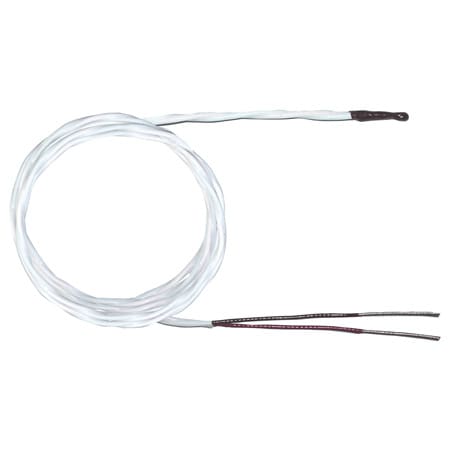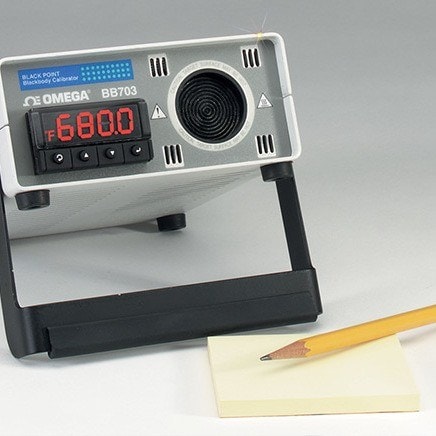Because several different types of temperature sensors are available and each type has its own unique characteristics, choosing the right one for your application can be tricky. Thermistors are among the most commonly used temperature sensors, and offer high stability, good accuracy and fairly rapid response times for a low per-unit cost. This makes them ideal for a wide array of use cases.
NTC Thermistors vs. Resistance Temperature Detectors (RTDs)
Both thermistors and resistance temperature detectors (RTDs) are types of resistors with resistance values that vary predictably with changes in their temperature. Most RTDs consist of an element made of a pure metal (platinum is most commonly used) and protected within a probe or sheath or embedded into a ceramic substrate. Thermistors are made up of composite materials, usually metal oxides such as manganese, nickel or copper, along with binding agents and stabilizers.
Whereas in RTDs there is a positive correlation between resistance and temperature (as temperature increases, resistance increases as well), in negative temperature coefficient (NTC) thermistors, the inverse relationship holds (resistance decreases as temperature increases). The relationship between temperature and resistance is linear for RTDS, but for NTC thermistors, it is exponential and can be plotted along a curve.
Both RTDs and NTC thermistors require a current or excitation source, and both are suitable for use in applications that require:
- Accuracy
- Good long-term stability
- Immunity to electrical noise in the environment
| Sensor Type | Thermistor | RTD |
| Temperature Range (typical) | -100 to 325°C | -200 to 650°C |
| Accuracy (typical) | 0.05 to 1.5°C | 0.1 to 1°C |
| Long-term stability @ 100°C | 0.2°C/year | 0.05°C/year | Linearity | Exponential | Fairly linear | Power required | Constant voltage or current | Constant voltage or current | Response time | Fast 0.12 to 10s | Generally slow 1 to 50s | Susceptibility to electrical noise | Rarely susceptible high resistance only | Rarely susceptible | Cost | Low to moderate | High |
Available Thermistor Configurations
Thermistors are available in several common configurations. The three most frequently employed are the hermetically sealed flexible thermistor (HSTH series), the bolt-on/washer type and the self-adhesive surface-mount style.
HSTH Thermistors are completely sealed within PFA (plastic polymer) jackets to protect the sensing element from moisture and corrosion. They can be used to measure the temperature of an array of liquids ranging from oils and industrial chemicals to foods.
Thermistors with bolt- or washer-mounted sensors can be installed into standard-sized threaded holes or openings. Their small thermal mass enables them to respond to temperature changes rapidly. They’re used in a many applications including household appliances, water tanks, pipes and equipment casings.
Surface-mounted thermistors come with adhesive exteriors that can easily be stuck in place on flat or curved surfaces. They can be removed and re-applied and have several commercial and industrial applications.
Temperature Range, Accuracy and Stability
Thermistors are highly accurate (ranging from ± 0.05°C to ± 1.5°C), but only over a limited temperature range that is within about 50°C of a base temperature. The working temperature range for most thermistors is between 0°C and 100°C. Class A thermistors offer the greatest accuracy, while Class B thermistors can be used in scenarios where there’s less need for exact measurement. Once the manufacturing process is complete, thermistors are chemically stable and their accuracy does not change significantly with age.
Common Applications for Thermistors
Thermistors are employed in a broad array of commercial and industrial applications to measure the temperature of surfaces, liquids and ambient gasses. When sheathed in protective probes that can be reliably sanitized, they’re used in the food and beverage industries, in scientific laboratories and in R&D. Heavy-duty probe mounted thermistors are suitable for immersion in corrosive fluids, and can be used in industrial processes, while vinyl-tipped thermistor mounts are used outdoors or for biological applications. Thermistors are also available with metal or plastic cage-style element covers for air temperature measurement.
How Do You Wire Your Thermistor?
Thermistors are very simple to wire. Most come with two-wire connectors. The same two wires that connect the thermistor to its excitation source can be used to measure the voltage across the thermistor.


